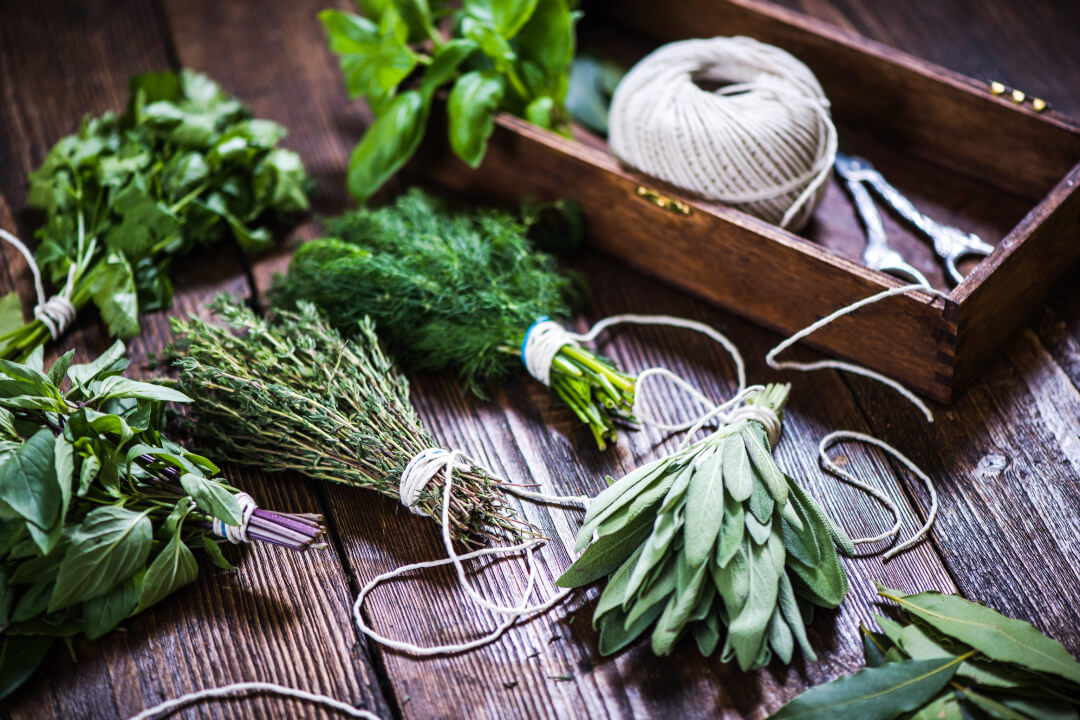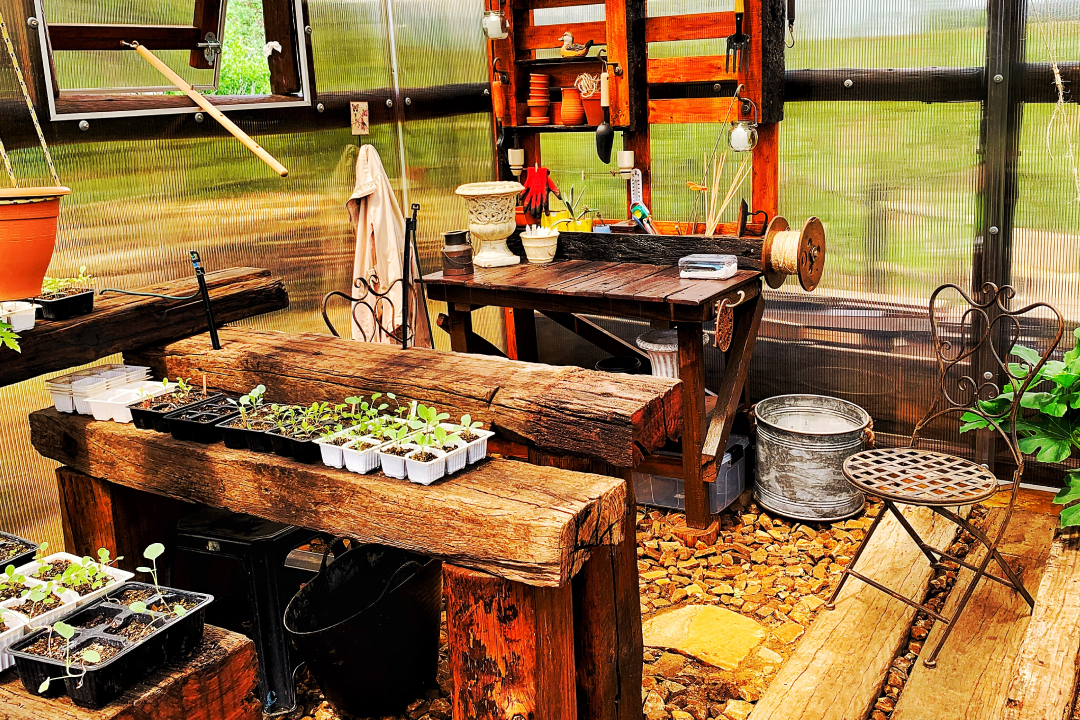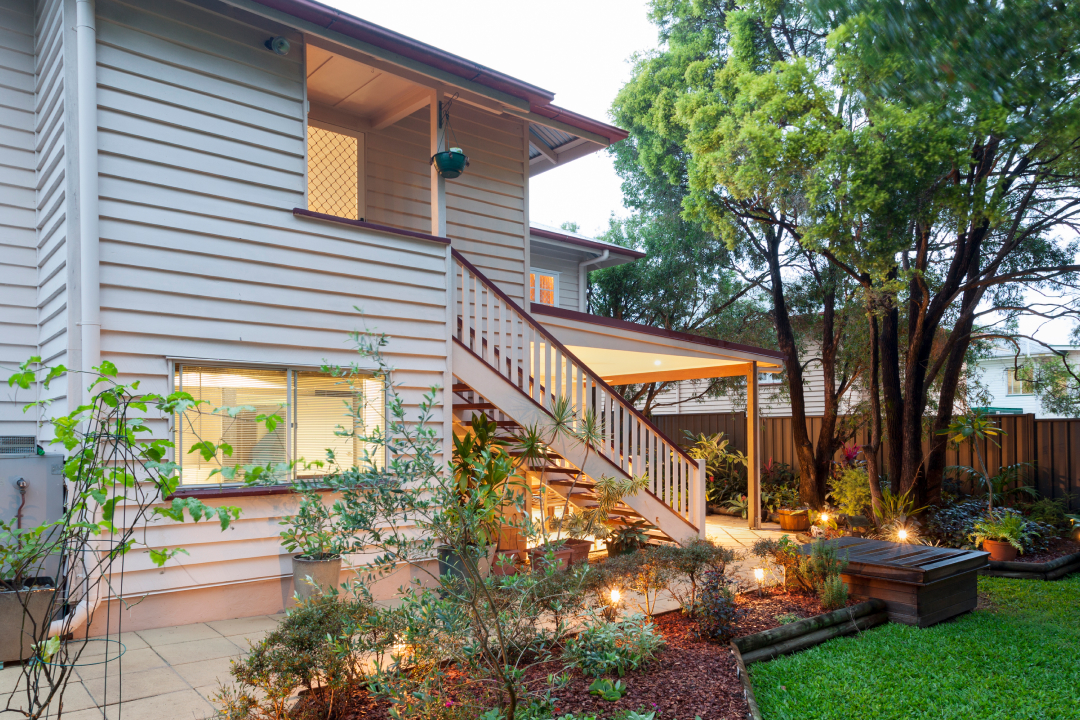Imagine stepping out your backdoor to harvest fresh fruit, nuts, herbs, and vegetables from a lush, low-maintenance oasis.
Here at the Orchard, we’ve created this vision by planting a food forest—an edible ecosystem that mimics a natural forest. The Sunshine Coast Hinterland’s subtropical climate makes growing a food forest especially rewarding as we have long growing seasons and lots of plant choices.
A food forest can be grown in any climate. It’s all about choosing the plants that will grow where you live. Here’s what we did to transform our front yard (it’s on the Northern side of the house) into a productive, self-sustaining food forest.
What is a Food Forest?
A food forest is a layered garden system inspired by the structure of a natural forest. It involves planting various species in layers—each with a specific function—that work together to support each other. A typical food forest has seven layers:
- Canopy layer with tall fruit and nut trees
- Understory of smaller fruit trees and shrubs
- Shrub layer with berry bushes
- Herbaceous layer with herbs and vegetables
- Ground cover layer with low-growing plants like clover
- Vine layer with climbing plants
- Root layer with tubers and root vegetables
This design creates a balanced ecosystem that attracts beneficial insects, conserves water, improves soil health, and reduces the need for fertilisers or pesticides.
Step 1: Planning Your Food Forest
Before you start digging, take some time to observe your space. Note the sunlight, shade, and any wet or dry areas in your backyard. Since Queensland has a sunny, often humid climate, our forest thrives in full to partial sun. If your space is small, focus on dwarf or compact tree varieties and plant intensively for maximum yield.
All our trees are dwarf varieties and include a range of citrus and tropical fruits. We have a mix of plants in the ground and in pots to take maximum advantage of the sun and yard space available.
The three most important ingredients for creating a successful food forest are:
- Size: Food forests can fit into a small suburban yard or cover an acre. Choose plants that match the scale of your yard.
- Sunlight: Most fruit trees need full sun, so ensure your canopy trees don’t completely block light for lower layers.
- Soil: Prepare your soil before planting, adding organic compost or worm castings will improve soil health and structure. Mushroom compost is our additive of choice.
Step 2: Choosing Plants for Your Climate
Queensland’s warm climate allows for a variety of tropical and subtropical species, many of which are ideal for a food forest. Below are suggestions that we considered for each layer of our food forest.
Canopy Layer
- Avocado: Hardy, produces high yields, and loves Queensland’s warmth.
- Macadamia: An Australian native that thrives in subtropical regions.
- Mango: A classic Queensland tree, offering delicious fruits and ample shade.
We added all three of these trees to our canopy and are looking forward to harvesting our bounty when the time comes.
Understory Layer
- Citrus (e.g., lemon, lime, orange): Great for smaller spaces and ideal as secondary trees.
- Guava: A smaller tree that provides tasty fruit and can tolerate light shade.
- Papaya: Fast-growing and highly productive, with both fruit and leaves that are edible.
Our understory features two varieties each of lemon, lime and oranges as well as a kumquat, pomegranate and apple tree – all dwarf varieties.
Shrub Layer
- Blueberry: With the right soil (slightly acidic) and right variety, blueberries can produce well in subtropical climates.
- Pineapple guava: Drought-tolerant and attractive, it also produces delicious fruit.
- Chilean guava: A small shrub that is perfect for filling in spaces and offering edible berries.
We opted for blueberries, pineapples and a dwarf mulberry.
Herbaceous Layer
- Ginger and turmeric: Thrive in Queensland’s warm, humid climate and can be used fresh or dried.
- Lemongrass: A hardy, clumping herb that deters pests and adds flavour to dishes.
- Comfrey: A fast-growing plant with deep roots that bring nutrients to the surface, ideal for soil health.
We also added chicken greens and cat grass for our dogs to keep everyone at the Orchard happy!
Ground Cover Layer
- Sweet potato: Both the tubers and leaves are edible, and it spreads quickly.
- Strawberry: These make a beautiful and productive ground cover for sunny areas.
- Creeping thyme: Provides aromatic ground cover and attracts pollinators.
So far, we have pumpkin, rock melon and watermelon interplanted with oregano and thyme. We planted our strawberries in a ladder garden to keep them safe from the chooks. Once our soil and plants are more established we’ll add sweet potato to the mix.
Vine Layer
- Passionfruit: This vigorous vine thrives in Queensland and provides abundant fruit.
- Choko: A hardy vine that produces versatile, high-yield vegetables.
- Malabar spinach: A heat-tolerant, perennial green that climbs and produces edible leaves year-round.
We have two passionfruit vines and have included bougainvillea bambinos for colour and pollinator appeal. All of these are growing on trellises to protect our growing fruit tree canopy.
Root Layer
- Cassava: A drought-tolerant, perennial root crop.
- Taro: Requires consistent moisture, ideal if you have a wet spot in your yard.
- Yacon: Produces sweet, crunchy tubers and is easy to grow.
Your food forest doesn’t have to be made up of all seven layers, you can create one using just three layers if your garden is pot-based. We’re yet to introduce a root layer but adding sweet potato will address this as well as adding to our ground covers.
Step 3: Building and Maintaining Your Food Forest
Start with Soil Preparation
Prepare the soil by adding organic compost, worm castings, and mulch to improve structure and fertility. Natural soils vary, but food forests thrive with plenty of organic matter.
Planting in Layers
Begin by planting the canopy trees, allowing ample space between each. Follow up with your understory and shrubs, filling in the empty spaces with herbs, ground cover, vines, and root crops. Plant intensively to maximise yield and shade the soil, which will help reduce evaporation and weed growth.
Mulching and Watering
Our hot summers mean water conservation is essential. We added thick layers of sugarcane mulch around the plants to retain soil moisture, regulate temperature, and suppress weeds. Deep mulch (10 cm or more) will break down over time, continuously improving your soil.
Consider installing a rainwater tank or drip irrigation system to support your forest during dry spells. We were lucky that our house came with a 30 000 litre underground tank. It fills during the wet season guaranteeing we have ample water over our dry winter.
Companion Planting
I love companion planting! Use plants like comfrey, lemongrass, and marigold as companion plants. They deter pests, attract pollinators, and contribute to soil health. For example, nitrogen-fixing plants like broad beans add nutrients back to the soil, benefiting your fruit trees.
Read more about the benefits of companion planting in this blog post (insert link)
Step 4: Maintenance
A food forest is relatively low maintenance once established, but the first few years require regular care.
- Pruning: Keep trees and shrubs pruned to maintain light flow and avoid overcrowding. Pruning also encourages growth and fruiting.
- Mulching: Top up mulch regularly to maintain soil health and moisture.
- Weeding and Pest Control: Weeds are minimal in a healthy food forest but remove any invasive plants that compete for resources. Use organic pest control methods or attract beneficial insects to keep pests in check.
- Fertilising: Supplement with compost tea, worm castings, or seaweed solution as needed.
Enjoying the Harvest
With time, patience, and care, your food forest will become a thriving ecosystem that provides year-round harvests. The beauty of a food forest is that it continues to evolve, with plants self-seeding, soil improving, and wildlife creating natural balance.
I’ve loved seeing the changes in our garden over the past few years. We’ve gradually reduced the weeds which were rampant when we first moved in. Our citrus trees and blueberries are fruiting and soon we’ll be able to enjoy our first mango and avocado harvests.
Final Thoughts
Growing a food forest in your backyard is a journey towards sustainable living, allowing you to reduce grocery bills, conserve water, and enhance biodiversity. In addition to fresh produce, your forest will offer beauty, wildlife habitat, and a sense of connection to the land.
By following these steps and adapting to the needs of your environment, you can transform your yard into a lush, productive haven that nourishes both your family and the local ecosystem.
If you’d like help to begin creating your own food forest please get in touch or leave a comment below.



